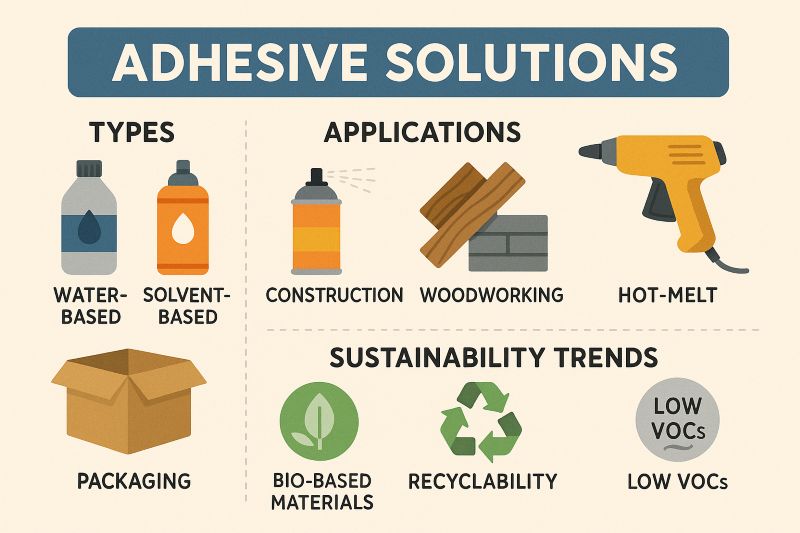
Definition of Adhesive Solutions
Types: Traditional vs. Bio-Based
Importance of Adhesive Selection
Methods for Adhesive Application
Latest Trends in Adhesives
Strategies for Adhesive Use
Comparative Analysis
Frequently Asked Questions (FAQ)
Adhesive solutions are essential materials used across industries to ensure strong and reliable bonding. While traditional adhesives are typically derived from petroleum-based sources, offering high performance, they also present environmental challenges. In contrast, bio-based adhesives, developed from renewable resources, provide more sustainable alternatives. These environmentally conscious options are gaining traction in applications that require both performance and ecological responsibility.
Adhesives generally fall into two main categories: traditional and bio-based. Traditional adhesives are often synthetic, made from fossil fuel derivatives, and are known for their durability and strength. However, their environmental footprint has led to increased interest in bio-based adhesives, which are formulated from renewable biological sources. These alternatives aim to deliver comparable bonding properties while supporting sustainability initiatives in various industries.
Choosing the right adhesive can significantly impact both performance and sustainability outcomes. Traditional adhesives are valued for their strength and reliability but may conflict with environmental goals due to their synthetic nature. Bio-based adhesives, made from renewable inputs, offer a balance of effective bonding and reduced environmental harm. Proper adhesive selection ensures that technical requirements are met while also supporting long-term ecological strategies.
Adhesives can be applied through various methods depending on the formulation and end-use requirements. Traditional adhesives may require manual or temperature-sensitive techniques to achieve effective bonds. In contrast, newer bio-based adhesives are often compatible with modern application systems such as spray, roll, or automated dispensing. These methods can enhance efficiency, minimize waste, and improve consistency in production environments.
The adhesive industry is increasingly focused on eco-friendly innovation. One of the most prominent trends is the development of adhesives that maintain strong bonding capabilities while being formulated from bio-based sources. This movement reflects a broader push for sustainable materials in response to regulatory pressures and consumer preferences. Additionally, advancements in adhesive chemistry are allowing for improved performance in demanding applications without relying on petroleum-based inputs.
Implementing effective adhesive use strategies begins with evaluating the technical requirements of the application, such as substrate type, environmental exposure, and bond strength. Traditional adhesives remain suitable for heavy-duty industrial tasks, but bio-based alternatives now offer reliable performance with added environmental benefits. Companies should also consider the application method to optimize productivity, particularly in operations looking to minimize material waste and carbon footprint.
A comparison between traditional and bio-based adhesives highlights a key shift in material science and sustainability. While traditional adhesives provide proven performance, their environmental drawbacks are prompting many companies to explore greener solutions. Bio-based adhesives have evolved to meet these demands, offering competitive bonding performance and aligning with environmental standards. Understanding the trade-offs between these types allows businesses to make informed, responsible choices.
Q: What are adhesive solutions?
A: Adhesive solutions are substances used to bond two surfaces together and are commonly used across manufacturing, packaging, and construction industries.
Q: What is the difference between traditional and bio-based adhesives?
A: Traditional adhesives are petroleum-based and known for strong bonds, while bio-based adhesives are made from renewable sources and offer environmentally friendly alternatives.
Q: Why is adhesive selection important?
A: The correct adhesive improves product reliability and can reduce environmental impact, depending on whether a traditional or bio-based formulation is used.
Q: Can you give examples of bio-based adhesive benefits?
A: Bio-based adhesives support sustainability goals, reduce reliance on fossil fuels, and can lower emissions throughout the product lifecycle.
Q: What application methods are commonly used?
A: Application methods include manual application, automated dispensing, spraying, and rolling, with many modern adhesives designed to fit multiple techniques.
Q: What are the key trends in adhesive development?
A: The industry is shifting toward adhesives that are both high-performing and bio-based, driven by regulatory requirements and market demand for sustainable products.
Q: What factors influence adhesive strategy?
A: Key factors include the material to be bonded, environmental conditions, regulatory compliance, and whether sustainability is a business objective.
Q: How do traditional adhesives impact sustainability efforts?
A: While effective, traditional adhesives often contribute to environmental concerns such as non-biodegradability and higher carbon emissions.